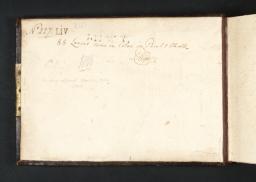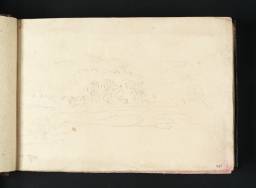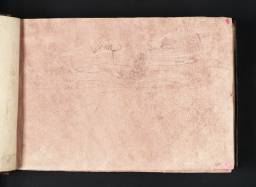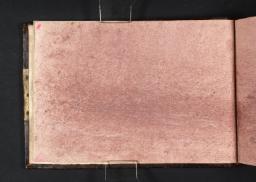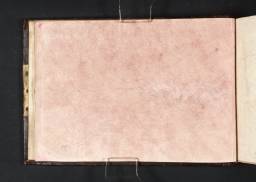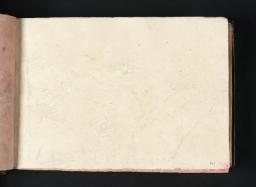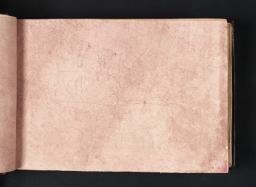Turner Bequest LIV 1–116a
Sketchbook bound in boards covered in calf leather, with one broken brass clasp
116 leaves of white wove paper, with single modern flyleaves of speckled off-white paper at front and back; most pages washed with a mauve-pink ground; page size 115 x 164 mm; watermark ‘1794 | J Whatman’
Inscribed by Turner in ink ‘90 Scotland’ on label on spine (D40777)
Numbered 227 as part of the Turner Schedule in 1854, and endorsed by the Executors of the Turner Bequest inside front cover (D40778)
Blind-stamped with Turner Bequest monogram on front cover, top left
116 leaves of white wove paper, with single modern flyleaves of speckled off-white paper at front and back; most pages washed with a mauve-pink ground; page size 115 x 164 mm; watermark ‘1794 | J Whatman’
Inscribed by Turner in ink ‘90 Scotland’ on label on spine (D40777)
Numbered 227 as part of the Turner Schedule in 1854, and endorsed by the Executors of the Turner Bequest inside front cover (D40778)
Blind-stamped with Turner Bequest monogram on front cover, top left
Accepted by the nation as part of the Turner Bequest 1856
References
This is one of the group of sketchbooks that Turner took with him on his tour to Scotland and the Lake District in the autumn of 1801. Although the artist labelled it ‘Scotland’ (see D40777), Finberg renamed it ‘Dunbar’1 to distinguish it from the other books used in the course of the itinerary: Edinburgh, Scotch Lakes, Tummel Bridge, and Scotch Figures (Tate; Turner Bequest LV, LVI, LVII, LIX). The English sections of the journey are represented by the Helmsley, Guisborough Shore and Chester sketchbooks (Tate; Turner Bequest LIII, LII, LXXXII). There are some Yorkshire and Northumberland subjects in the present book, too.
For the most part, Turner seems to have drawn in this sketchbook in the reverse order of the present page numbering, and many of the images are inverted relative to the foliation. Topographically they progress from Rievaulx, Scarborough and Whitby in Yorkshire, northwards along the Northumbrian coast and into Berwickshire, where he drew the sequence of dramatically sited castle ruins along the coast: Fast, Dunbar and Tantallon. These do not occur in geographical order. He proceeded to North Berwick in East Lothian, and on to Roslin, south of Edinburgh, where he made a fair number of drawings, though these are all rather slight. The drawing of Rievaulx on folio 1 recto (D02614) is consequently out of sequence and should be seen as part of the suite of Rievaulx subjects that occurs towards the end of the book (folios 102 verso–106 verso; D02784–D02792).
The final leaves (folios 108–116; D02795–D02810) had been removed from an earlier point in the book (see the technical notes below); they seem to have been drawn on while Turner was still in Yorkshire, having much in common with the series of studies along a rocky coast that occur in the little Guisborough Shore sketchbook (Tate; Turner Bequest LII). Turner is likely to have taken lodgings in Edinburgh before visiting Roslin, as suggested by the note inside the back cover of the Scotch Lakes sketchbook (Tate; Turner Bequest LVI): ‘Edinburgh to Roslyn 6 M ¼’.
Several obvious sites are not recorded here: Turner had followed a similar route on his tour of 1797, when he travelled from York and Ripon to Berwick and the Abbeys of the Tweed Valley, and he did not, for the most part, return to places already covered on that visit. Many of these sites, however, recur in three sketchbooks, Bass Rock and Edinburgh, Edinburgh, 1818, and Scotch Antiquities (Tate; Turner Bequest CLXV, CLXVI, CLXVII), which Turner used on his tour of Scotland in 1818, collecting material for the Provincial Antiquities of Scotland, issued from 1819 with text by Sir Walter Scott. In 1822 he returned to Edinburgh by ship, making sketches of places on the Berwickshire and East Lothian coast from out at sea in the King’s Visit to Scotland sketchbook (TB CC). As Finberg observes: ‘The wild and desolate scenes between St. Abb’s Head and Dunbar seem to have deeply impressed Turner’s imagination’.2
Finberg recorded John Ruskin’s inscription on an old wrapper: ‘227. The Brown book at Dunbar. Many fine rough sketches on brown paper’.3
Technical notes
Revised by Matthew Imms
How to cite
Andrew Wilton, ‘Dunbar sketchbook 1801’, sketchbook, May 2013, in David Blayney Brown (ed.), J.M.W. Turner: Sketchbooks, Drawings and Watercolours, Tate Research Publication, April 2016, https://www

